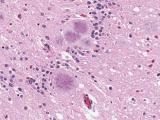Jul 11, 2006 (CIDRAP News) A blood test detected prions in animals during the asymptomatic phase of infection with scrapie, a transmissible spongiform encephalopathy (TSE), according to a study in the Jul 7 issue of Science.
The authors say the test offers the possibility of detecting other prion diseases, such as variant Creutzfeldt-Jakob disease (vCJD) in humans. By detecting prions during the silent phasejust weeks after infectionthe test could help identify infected blood and prevent disease transmission from those who are years from showing clinical signs of disease, the authors write.
Three human cases of vCJD linked to blood transfusions have been reported thus far, and a study in the British Medical Bulletin has demonstrated transmission via blood in experimental sheep-to-sheep transmission of scrapie, the article notes.
Claudio Soto of the University of Texas Medical Branch (UTMB) in Galveston and colleagues from UTMB and Madrid, Spain, used a "protein misfolding cyclic amplification" (PMCA) assay to detect abnormal prion protein in asymptomatic, scrapie-infected hamsters. They previously reported successful use of the test in hamsters with clinical signs of scrapie.
PMCA uses blood samples from scrapie-infected hamsters and control animals for the test. To start the test, researchers mix the "buffy coat" of white blood cells from infected animals with homogenized samples of hamster brain containing normal prion protein. The mixtures incubate at 37ºC, then are briefly subjected to sound waves and reincubated. The presence of abnormal prion proteins catalyzes conversion of normal prion protein to the abnormal, misfolded form. Sonication breaks up clumps of abnormal prion protein and facilitates conversion of more normal prion protein to the abnormal state.
After multiple repetitions of the process, any disease-causing abnormal prion protein in the blood sample will convert normal protein to the misfolded protein. Abnormal prion protein can then be detected by existing tests, such as a Western blot. The authors state that their procedure will detect 20 to 50 molecules of hamster prion protein, an amount that seems to correspond to a single unit of infectious prion protein.
In the study, 46 animals were inoculated with brain tissue from scrapie-infected sheep, and 38 control animals were injected with phosphate-buffered saline. Throughout the incubation and onset of clinical disease, infected animals and controls were killed and their blood tested for abnormal PRP. All tests were performed in triplicate.
No abnormal prion protein was detectable before 20 days after infection. Abnormal prion protein was detectable during most of the presymptomatic phase, rising to a peak in animals tested at 40 days post-infection. Such a rise probably coincided with exponential replication of abnormal prion protein in lymphoid organs, according to the authors.
Abnormal prion protein disappeared from the blood by day 80, but it reappeared at the time of clinical disease onset at about day 110. The researchers suggest that the disappearance of abnormal prion protein coincided with a plateau in peripheral tissues and migration to the brain.
Detection of abnormal prion protein during the early phase, therefore, was likely from replication in peripheral tissues, whereas abnormal prion protein from the symptomatic phase was more likely due to leakage from the brain. The authors say this is believed to be the pattern observed in many prion diseases.
The authors write, "Although technologically more challenging, the PMCA technology has been adapted to amplify prions of human origin. The ability to accurately detect misfolded prion proteins in the pre-symptomatic stages of vCJD would potentially help to reduce the risk that many more people will be infected by this fatal and terrible disease."
Development of a human test, however, awaits further refinement of the procedure, according to others. In a BBC News story, an unidentified spokesperson for the United Kingdom Health Protection Agency pointed out one barrier to applying the test in humans, saying, "A brain extract from healthy hamsters was used to undertake the test. Until a substitute is found for human brain extract, we cannot have a diagnostic test that can be applied to human blood."
Saa P, Castilla J, Soto C. Presymptomatic detection of prions in blood. Science 2006 Jul 7;313(5783):92-4 [Abstract]
See also:
Aug 29, 2005, CIDRAP News story "Blood test for prion diseases reported"
















